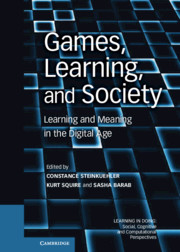Book contents
- Frontmatter
- Contents
- Contributors
- Series Foreword
- Foreword
- Acknowledgments
- Section I Games as Designed Experience
- Section II Games as Emergent Culture
- Section III Games as Twenty-First-Century Curriculum
- 17 Introduction to Section III
- 18 Prediction and Explanation as Design Mechanics in Conceptually Integrated Digital Games to Help Players Articulate the Tacit Understandings They Build through Game Play
- 19 Game-Based Curricula, Personal Engagement, and the Modern Prometheus Design Project
- 20 Discovering Familiar Places
- 21 Developing Gaming Fluencies with Scratch
- 22 “Freakin’ Hard”
- 23 Models of Situated Action
- Afterword Games and the Future of Education Research
- Index
- References
22 - “Freakin’ Hard”
Game Design and Issue Literacy
Published online by Cambridge University Press: 05 August 2012
- Frontmatter
- Contents
- Contributors
- Series Foreword
- Foreword
- Acknowledgments
- Section I Games as Designed Experience
- Section II Games as Emergent Culture
- Section III Games as Twenty-First-Century Curriculum
- 17 Introduction to Section III
- 18 Prediction and Explanation as Design Mechanics in Conceptually Integrated Digital Games to Help Players Articulate the Tacit Understandings They Build through Game Play
- 19 Game-Based Curricula, Personal Engagement, and the Modern Prometheus Design Project
- 20 Discovering Familiar Places
- 21 Developing Gaming Fluencies with Scratch
- 22 “Freakin’ Hard”
- 23 Models of Situated Action
- Afterword Games and the Future of Education Research
- Index
- References
Summary
We had ambitious goals for the Boys & Girls Clubs of America’s GameTech Program. We set out to use the lens of game design to expose nine- to thirteen-year-old youth to systems thinking, basic programming skills, the iterative design process, game-design concepts, and understanding the dynamics of real-world issues, something we call issue literacy. This was an incredible laundry list of pedagogical goals, each alone presenting its own complexities and together posing a rather daunting curriculum design challenge. The issues we encountered were numerous but can be boiled down to five core challenges: teaching the software tools to the point where they were not the locus of attention, instilling a deep understanding of games and systems thinking, the complexity of finding form-appropriate means of addressing issues in games, creating issue literacy, and the difficulties in assisting teachers and facilitators in teaching all the above.
This chapter is a travelogue of our work in this space, the challenges we faced along the way, and our encounters with other programs and projects pursuing similar goals. In the pages that follow we will explore the challenges in combining active learning through game design with differing forms of issue literacy and civic engagement. While the connections among game play, learning, and civic engagement have been explored and studied widely (Lenhart et al., 2008), using game design, not game play, as an entry point to learning about social and civic concerns is a much less explored pedagogical space. We will look at the difficulties presented by this curricular approach, our investigation of programs with similar pedagogical objectives, and how we refactored our approach in Activate!, a more recent online curriculum we developed for thirteen- to fifteen-year-olds. Framing our discussion is the question: Is learning to make games a natural next step in game-based learning programs, or is it a complete departure from programs based on play?
- Type
- Chapter
- Information
- Games, Learning, and SocietyLearning and Meaning in the Digital Age, pp. 381 - 402Publisher: Cambridge University PressPrint publication year: 2012
References
- 1
- Cited by



